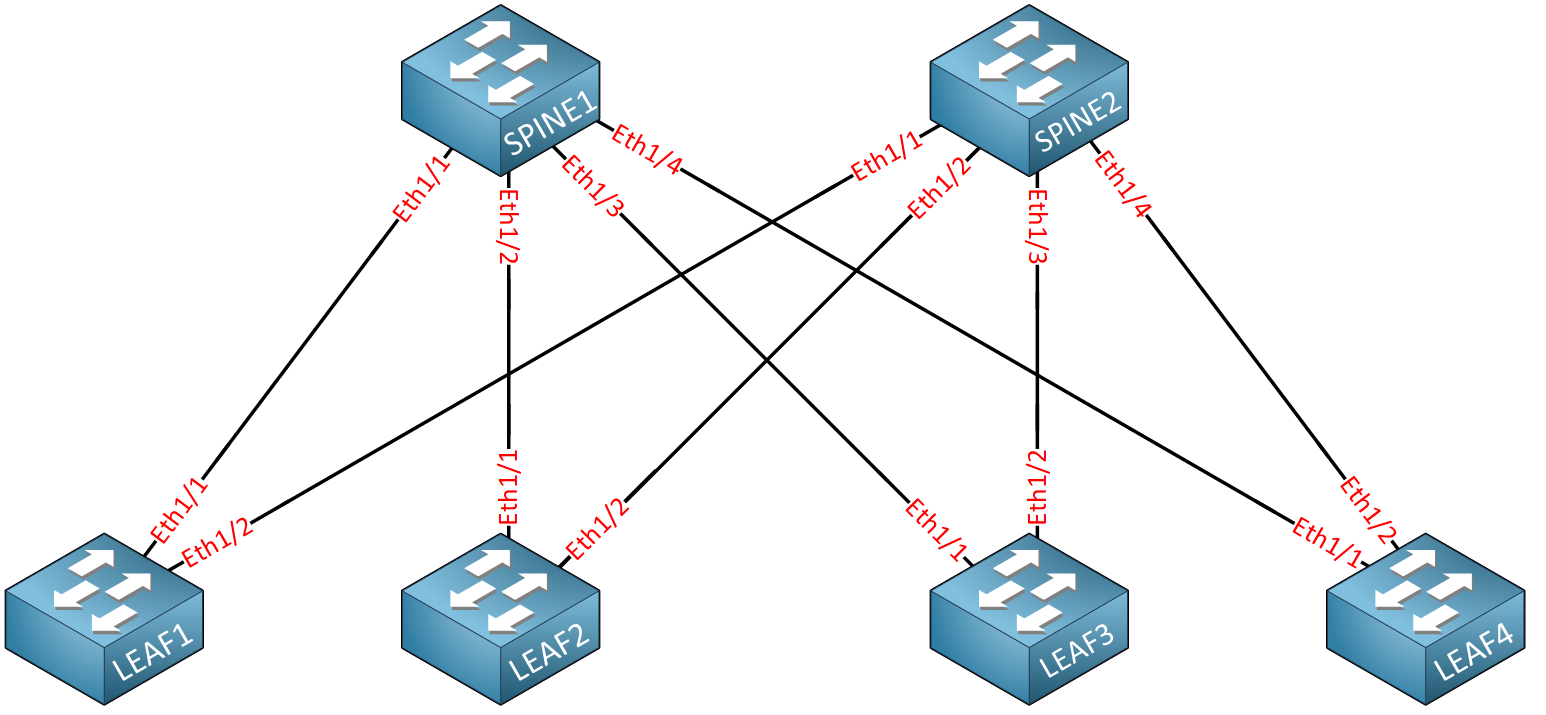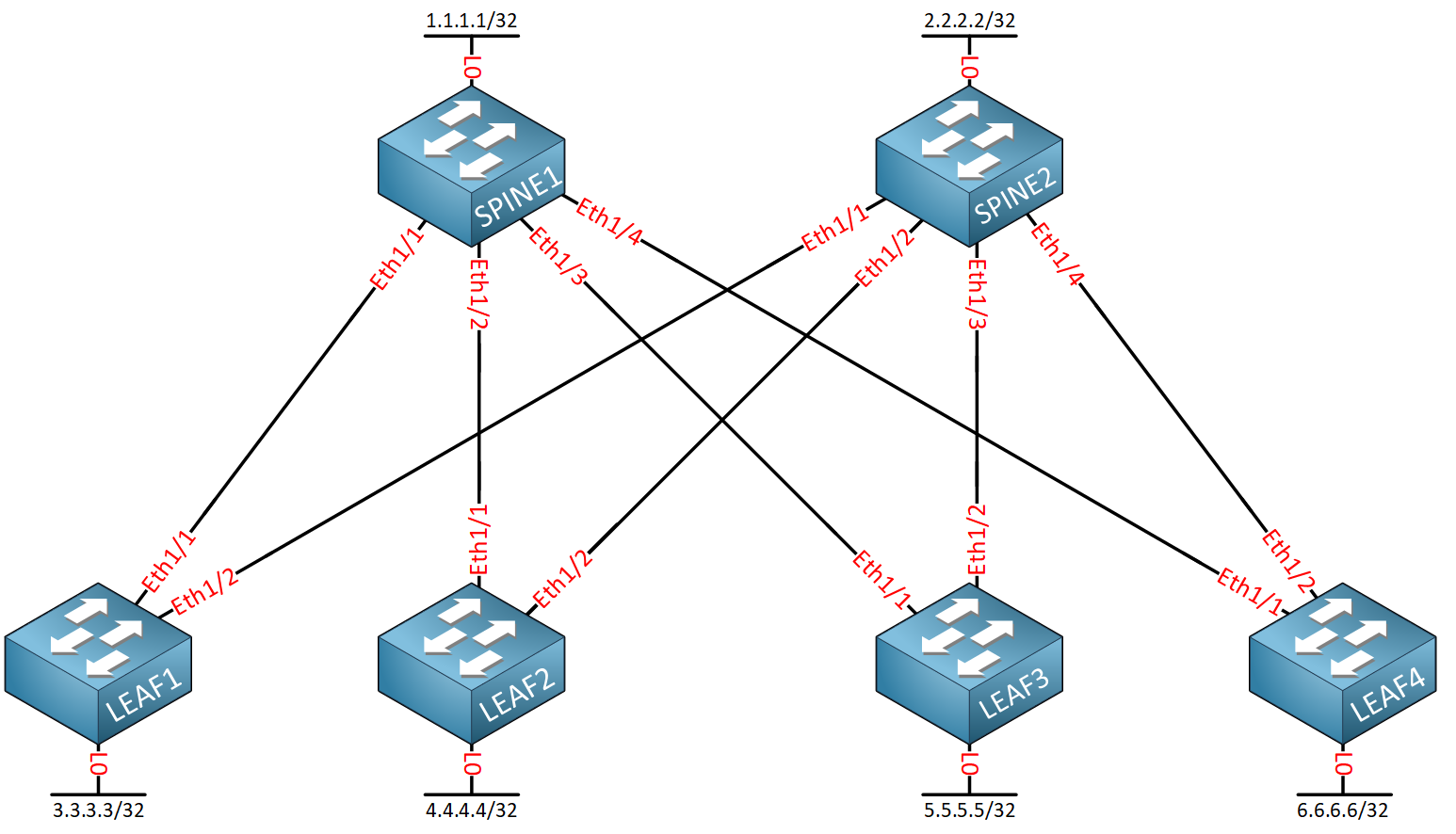Lesson Contents
VXLAN requires an underlay network so VTEPs can reach each other. We typically use a routing protocol to advertise the loopback interfaces of the VTEPs. You can choose between BGP, OSPF, or IS-IS as the routing protocol for your underlay network.
IS-IS is a link-state routing protocol similar to OSPF. IS-IS is not as popular as OSPF outside of service provider networks. It does not run on IP but uses connectionless network service (CLNS). This has an advantage because IS-IS is decoupled from what it advertises. It supports IPv4 and IPv6.
Like OSPF, IS-IS requires a unique identifier per router. This is the network entity title (IS-IS-NET). There is also something similar to OSPF’s DR/BDR election, but IS-IS has a designated intermediate system (DIS) election process. We have to keep this in mind. We only have point-to-point links, so we don’t need a DIS. We can disable it by changing our links to point-to-point.
Unlike OSPF, IS-IS does not perform a full SPF calculation when an IP prefix change occurs. IP prefix information is carried in type-length values (TLVs) and treated as external.
IS-IS supports /31 point-to-point links and also ip unnumbered.
OSPF and IS-IS are similar in a way. The VXLAN fabric has a simple topology, so configuring IS-IS is straightforward. I’ll explain how to configure 31 prefixes and IP unnumbered.
Configuration
Let’s start with the physical topology:

We have two spine and four leaf switches. I’m using Cisco NX-OS 9000v version 10.4.5 on all switches. We should start by setting the correct MTU. The highest possible MTU can differ depending on your platform and OS version. On these Cisco NX-OS switches, the highest possible MTU value is 9216.
Let’s configure it on the spine switches:
SPINE1 & SPINE2
(config)# interface Ethernet 1/1-4
(config-if-range)# mtu 9216And also on the leaf switches:
LEAF1-LEAF4
(config)# interface Ethernet 1/1-2
(config-if-range)# mtu 9216Now, we can focus on IS-IS.
/31 Prefixes
On “normal” point-to-point links, you would use a /30 prefix. This means you’ll have:
- Network address
- Two usable IP addresses for hosts
- Broadcast address
A /31 prefix only has two IP addresses and can be used for point-to-point links. This will save you a lot of IP addresses. Let’s look at an example.
Let’s say we have 4 spine switches and 20 leaf switches. This means we’ll have 4 x 20 = 80 point-to-point links:
- 80 point-to-point links x 4 IP addresses ( /30 prefixes) = 320 IP addresses required for point-to-point links.
- 80 point-to-point links x 2 IP addresses ( /31 prefixes) = 160 IP addresses required for point-to-point links.
Our switches also require loopback interfaces. We’ll need 4 for the spine switches and 20 for the leaf switches. That’s 24 IP addresses for loopbacks.
In total, we would need:
- /30 prefixes: 344 IP addresses
- /31 prefixes: 184 IP addresses
We’ll save quite some IP address space by using /31 prefixes. Here’s an example of what it could look like:

I took the 192.168.1.0/24 subnet and created many /31 prefixes for the physical interfaces. Let’s configure this on the switches.
Configurations
Want to take a look for yourself? Here, you will find the startup configuration of each device.
LEAF1
hostname LEAF1
interface Ethernet1/1
no switchport
mtu 9216
mac-address 0050.c253.3001
ip address 192.168.1.1/31
no shutdown
interface Ethernet1/2
no switchport
mtu 9216
mac-address 0050.c253.3002
ip address 192.168.1.9/31
no shutdown
interface loopback0
ip address 3.3.3.3/32LEAF2
hostname LEAF2
interface Ethernet1/1
no switchport
mtu 9216
mac-address 0050.c253.4001
ip address 192.168.1.3/31
no shutdown
interface Ethernet1/2
no switchport
mtu 9216
mac-address 0050.c253.4002
ip address 192.168.1.11/31
no shutdown
interface loopback0
ip address 4.4.4.4/32LEAF3
hostname LEAF3
interface Ethernet1/1
no switchport
mtu 9216
mac-address 0050.c253.5001
ip address 192.168.1.5/31
no shutdown
interface Ethernet1/2
no switchport
mtu 9216
mac-address 0050.c253.5002
ip address 192.168.1.13/31
no shutdown
interface loopback0
ip address 5.5.5.5/32LEAF4
hostname LEAF4
interface Ethernet1/1
no switchport
mtu 9216
mac-address 0050.c253.6001
ip address 192.168.1.7/31
no shutdown
interface Ethernet1/2
no switchport
mtu 9216
mac-address 0050.c253.6002
ip address 192.168.1.15/31
no shutdown
interface loopback0
ip address 6.6.6.6/32SPINE1
hostname SPINE1
interface Ethernet1/1
no switchport
mtu 9216
mac-address 0050.c253.1001
ip address 192.168.1.0/31
no shutdown
interface Ethernet1/2
no switchport
mtu 9216
mac-address 0050.c253.1002
ip address 192.168.1.2/31
no shutdown
interface Ethernet1/3
no switchport
mtu 9216
mac-address 0050.c253.1003
ip address 192.168.1.4/31
no shutdown
interface Ethernet1/4
no switchport
mtu 9216
mac-address 0050.c253.1004
ip address 192.168.1.6/31
no shutdown
interface loopback0
ip address 1.1.1.1/32SPINE2
hostname SPINE2
interface Ethernet1/1
no switchport
mtu 9216
mac-address 0050.c253.2001
ip address 192.168.1.8/31
no shutdown
interface Ethernet1/2
no switchport
mtu 9216
mac-address 0050.c253.2002
ip address 192.168.1.10/31
no shutdown
interface Ethernet1/3
no switchport
mtu 9216
mac-address 0050.c253.2003
ip address 192.168.1.12/31
no shutdown
interface Ethernet1/4
no switchport
mtu 9216
mac-address 0050.c253.2004
ip address 192.168.1.14/31
no shutdown
interface loopback0
ip address 2.2.2.2/32Now, let’s configure IS-IS. First, we need to enable the feature on all switches:
LEAF1-LEAF4, SPINE1 & SPINE2
(config)# feature isisLet’s start a new IS-IS process and configure a unique network entity title (IS-IS-NET):
SPINE1(config)# router isis UNDERLAY
SPINE1(config-router)# net 49.0012.0000.0000.0001.00SPINE2(config)# router isis UNDERLAY
SPINE2(config-router)# net 49.0012.0000.0000.0002.00LEAF1(config)# router isis UNDERLAY
LEAF1(config-router)# net 49.0012.0000.0000.0003.00LEAF2(config)# router isis UNDERLAY
LEAF2(config-router)# net 49.0012.0000.0000.0004.00LEAF3(config)# router isis UNDERLAY
LEAF3(config-router)# net 49.0012.0000.0000.0005.00LEAF4(config)# router isis UNDERLAY
LEAF4(config-router)# net 49.0012.0000.0000.0006.00We’ll call the process “UNDERLAY”.
By default, IS-IS will establish level 1 and level 2 neighbor adjacencies. I’ll change it so it only creates level 2 neighbor adjacencies and I’ll also enable logging of adjacency changes:
LEAF1-LEAF4, SPINE1 & SPINE2
(config)# router isis UNDERLAY
(config-router)# is-type level-2
(config-router)# log-adjacency-changesThat’s it.
Let’s enable IS-IS on the loopback interfaces:
LEAF1-LEAF4, SPINE1 & SPINE2
(config)# interface Loopback 0
(config-if)# ip router isis UNDERLAYLet’s configure IS-IS on the Ethernet interfaces. Make sure you set the network type to point-to-point so we don’t have a DIS election. We’ll start with the leaf switches:
LEAF1-LEAF4
(config)# interface Ethernet 1/1-2
(config-if-range)# isis network point-to-point
(config-if-range)# ip router isis UNDERLAYAnd here are the spine switches:
SPINE1 & SPINE2
(config)# interface Ethernet 1/1-4
(config-if-range)# isis network point-to-point
(config-if-range)# ip router isis UNDERLAYThat completes the configuration.
Verification
Let’s look at the IS-IS process in general:
SPINE1# show isis
ISIS process : UNDERLAY
Instance number : 1
UUID: 1090519320
Process ID 19208
VRF: default
System ID : 0000.0000.0001 IS-Type : L2
SAP : 412 Queue Handle : 12
Maximum LSP MTU: 1492
Stateful HA enabled
Graceful Restart enabled. State: Inactive
Last graceful restart status : none
Start-Mode Complete
BFD IPv4 is globally disabled for ISIS process: UNDERLAY
BFD IPv6 is globally disabled for ISIS process: UNDERLAY
Topology-mode is base
Metric-style : advertise(wide), accept(narrow, wide)
Area address(es) :
49.0012
Process is up and running
VRF ID: 1
Stale routes during non-graceful controlled restart
Enable resolution of L3->L2 address for ISIS adjacency
SRTE: Not registered
OAM: Not registered
SR IPv4 is not configured and disabled for ISIS process: UNDERLAY
SR IPv6 is not configured and disabled for ISIS process: UNDERLAY
SRv6 is disabled for ISIS process: UNDERLAY
Interfaces supported by IS-IS :
loopback0
Ethernet1/1
Ethernet1/2
Ethernet1/3
Ethernet1/4
Topology : 0
Address family IPv4 unicast :
Number of interface : 5
Distance : 115
Default-information not originated
Address family IPv6 unicast :
Number of interface : 0
Distance : 115
Default-information not originated
Topology : 2
Address family IPv4 unicast :
Number of interface : 0
Distance : 115
Default-information not originated
Address family IPv6 unicast :
Number of interface : 0
Distance : 115
Default-information not originated
Level1
No auth type and keychain
Auth check set
Level2
No auth type and keychain
Auth check set
L1 Next SPF: Inactive
L2 Next SPF: Inactive
Attached bits
MT-0 L-1: Att 0 Spf-att 0 Cfg 1 Adv-att 0
MT-0 L-2: Att 0 Spf-att 0 Cfg 1 Adv-att 0Above, you see some general information such as the process name, the level, and the interfaces we use. You can also see some information per interface:
SPINE1# show isis interface Ethernet 1/1
IS-IS process: UNDERLAY VRF: default
Ethernet1/1, Interface status: protocol-up/link-up/admin-up
IP address: 192.168.1.0, IP subnet: 192.168.1.0/31
IPv6 routing is disabled
No auth type and keychain
Auth check set
Index: 0x0002, Local Circuit ID: 0x01, Circuit Type: L2
Prefix suppress is disabled globally on interface Ethernet1/1
Level 1
Address-family IPv4 Advertise Passive only is disabled
Address-family IPv6 Advertise Passive only is disabled
Level 2
Address-family IPv4 Advertise Passive only is disabled
Address-family IPv6 Advertise Passive only is disabled
BFD IPv4 is locally disabled for Interface Ethernet1/1
BFD IPv6 is locally disabled for Interface Ethernet1/1
MTR is disabled
Extended Local Circuit ID: 0x1A000000, P2P Circuit ID: 0000.0000.0000.00
Retx interval: 5, Retx throttle interval: 66 ms
LSP interval: 33 ms, MTU: 9216
MTU check OFF on P2P interface
P2P Adjs: 1, AdjsUp: 1, Priority 64
Hello Interval: 10, Multi: 3, Next IIH: 00:00:01
MT Adjs AdjsUp Metric CSNP Next CSNP Last LSP ID
1 0 0 40 60 Inactive ffff.ffff.ffff.ff-ff
2 1 1 40 60 00:01:00 ffff.ffff.ffff.ff-ff
Topologies enabled:
L MT Metric MetricCfg Fwdng IPV4-MT IPV4Cfg IPV6-MT IPV6Cfg
1 0 40 no DN DN no DN no
2 0 40 no UP UP yes DN no The output above is helpful because it shows we have a point-to-point adjacency. Let’s check our neighbor adjacencies:
SPINE1# show isis adjacency
IS-IS process: UNDERLAY VRF: default
IS-IS adjacency database:
Legend: '!': No AF level connectivity in given topology
System ID SNPA Level State Hold Time Interface
LEAF1 N/A 2 UP 00:00:31 Ethernet1/1
LEAF2 N/A 2 UP 00:00:22 Ethernet1/2
LEAF3 N/A 2 UP 00:00:30 Ethernet1/3
LEAF4 N/A 2 UP 00:00:32 Ethernet1/4SPINE2# show isis adjacency
IS-IS process: UNDERLAY VRF: default
IS-IS adjacency database:
Legend: '!': No AF level connectivity in given topology
System ID SNPA Level State Hold Time Interface
LEAF1 N/A 2 UP 00:00:27 Ethernet1/1
LEAF2 N/A 2 UP 00:00:29 Ethernet1/2
LEAF3 N/A 2 UP 00:00:27 Ethernet1/3
LEAF4 N/A 2 UP 00:00:25 Ethernet1/4Each spine switch has four neighbor adjacencies, one with each leaf switch. Let’s check some routes:
SPINE1# show ip route isis
IP Route Table for VRF "default"
'*' denotes best ucast next-hop
'**' denotes best mcast next-hop
'[x/y]' denotes [preference/metric]
'%' in via output denotes VRF
2.2.2.2/32, ubest/mbest: 4/0
*via 192.168.1.1, Eth1/1, [115/81], 00:04:04, isis-UNDERLAY, L2
*via 192.168.1.3, Eth1/2, [115/81], 00:04:16, isis-UNDERLAY, L2
*via 192.168.1.5, Eth1/3, [115/81], 00:04:19, isis-UNDERLAY, L2
*via 192.168.1.7, Eth1/4, [115/81], 00:04:16, isis-UNDERLAY, L2
3.3.3.3/32, ubest/mbest: 1/0
*via 192.168.1.1, Eth1/1, [115/41], 00:04:04, isis-UNDERLAY, L2
4.4.4.4/32, ubest/mbest: 1/0
*via 192.168.1.3, Eth1/2, [115/41], 00:04:21, isis-UNDERLAY, L2
5.5.5.5/32, ubest/mbest: 1/0
*via 192.168.1.5, Eth1/3, [115/41], 00:04:21, isis-UNDERLAY, L2
6.6.6.6/32, ubest/mbest: 1/0
*via 192.168.1.7, Eth1/4, [115/41], 00:04:19, isis-UNDERLAY, L2
192.168.1.8/31, ubest/mbest: 1/0
*via 192.168.1.1, Eth1/1, [115/80], 00:04:04, isis-UNDERLAY, L2
192.168.1.10/31, ubest/mbest: 1/0
*via 192.168.1.3, Eth1/2, [115/80], 00:04:21, isis-UNDERLAY, L2
192.168.1.12/31, ubest/mbest: 1/0
*via 192.168.1.5, Eth1/3, [115/80], 00:04:21, isis-UNDERLAY, L2
192.168.1.14/31, ubest/mbest: 1/0
*via 192.168.1.7, Eth1/4, [115/80], 00:04:19, isis-UNDERLAY, L2SPINE2# show ip route isis
IP Route Table for VRF "default"
'*' denotes best ucast next-hop
'**' denotes best mcast next-hop
'[x/y]' denotes [preference/metric]
'%' in via output denotes VRF
1.1.1.1/32, ubest/mbest: 4/0
*via 192.168.1.9, Eth1/1, [115/81], 00:04:37, isis-UNDERLAY, L2
*via 192.168.1.11, Eth1/2, [115/81], 00:04:47, isis-UNDERLAY, L2
*via 192.168.1.13, Eth1/3, [115/81], 00:04:47, isis-UNDERLAY, L2
*via 192.168.1.15, Eth1/4, [115/81], 00:04:47, isis-UNDERLAY, L2
3.3.3.3/32, ubest/mbest: 1/0
*via 192.168.1.9, Eth1/1, [115/41], 00:04:37, isis-UNDERLAY, L2
4.4.4.4/32, ubest/mbest: 1/0
*via 192.168.1.11, Eth1/2, [115/41], 00:04:48, isis-UNDERLAY, L2
5.5.5.5/32, ubest/mbest: 1/0
*via 192.168.1.13, Eth1/3, [115/41], 00:04:48, isis-UNDERLAY, L2
6.6.6.6/32, ubest/mbest: 1/0
*via 192.168.1.15, Eth1/4, [115/41], 00:04:47, isis-UNDERLAY, L2
192.168.1.0/31, ubest/mbest: 1/0
*via 192.168.1.9, Eth1/1, [115/80], 00:04:37, isis-UNDERLAY, L2
192.168.1.2/31, ubest/mbest: 1/0
*via 192.168.1.11, Eth1/2, [115/80], 00:04:48, isis-UNDERLAY, L2
192.168.1.4/31, ubest/mbest: 1/0
*via 192.168.1.13, Eth1/3, [115/80], 00:04:48, isis-UNDERLAY, L2
192.168.1.6/31, ubest/mbest: 1/0
*via 192.168.1.15, Eth1/4, [115/80], 00:04:47, isis-UNDERLAY, L2This shows us everything we need. We see all IP addresses on the loopback interfaces advertised by IS-IS. Here’s one of the leaf switches:
LEAF1# show ip route isis
IP Route Table for VRF "default"
'*' denotes best ucast next-hop
'**' denotes best mcast next-hop
'[x/y]' denotes [preference/metric]
'%' in via output denotes VRF
1.1.1.1/32, ubest/mbest: 1/0
*via 192.168.1.0, Eth1/1, [115/41], 00:05:08, isis-UNDERLAY, L2
2.2.2.2/32, ubest/mbest: 1/0
*via 192.168.1.8, Eth1/2, [115/41], 00:05:07, isis-UNDERLAY, L2
4.4.4.4/32, ubest/mbest: 2/0
*via 192.168.1.0, Eth1/1, [115/81], 00:05:07, isis-UNDERLAY, L2
*via 192.168.1.8, Eth1/2, [115/81], 00:05:07, isis-UNDERLAY, L2
5.5.5.5/32, ubest/mbest: 2/0
*via 192.168.1.0, Eth1/1, [115/81], 00:05:07, isis-UNDERLAY, L2
*via 192.168.1.8, Eth1/2, [115/81], 00:05:07, isis-UNDERLAY, L2
6.6.6.6/32, ubest/mbest: 2/0
*via 192.168.1.0, Eth1/1, [115/81], 00:05:07, isis-UNDERLAY, L2
*via 192.168.1.8, Eth1/2, [115/81], 00:05:07, isis-UNDERLAY, L2
192.168.1.2/31, ubest/mbest: 1/0
*via 192.168.1.0, Eth1/1, [115/80], 00:05:08, isis-UNDERLAY, L2
192.168.1.4/31, ubest/mbest: 1/0
*via 192.168.1.0, Eth1/1, [115/80], 00:05:08, isis-UNDERLAY, L2
192.168.1.6/31, ubest/mbest: 1/0
*via 192.168.1.0, Eth1/1, [115/80], 00:05:08, isis-UNDERLAY, L2
192.168.1.10/31, ubest/mbest: 1/0
*via 192.168.1.8, Eth1/2, [115/80], 00:05:07, isis-UNDERLAY, L2
192.168.1.12/31, ubest/mbest: 1/0
*via 192.168.1.8, Eth1/2, [115/80], 00:05:07, isis-UNDERLAY, L2
192.168.1.14/31, ubest/mbest: 1/0
*via 192.168.1.8, Eth1/2, [115/80], 00:05:07, isis-UNDERLAY, L2LEAF1 knows how to reach the different loopback interfaces of the other leaf switches. The other leaf switches would show a similar output. This is everything we need to configure an overlay.
Configurations
Want to take a look for yourself? Here, you will find the final configuration of each device.
LEAF1
hostname LEAF1
feature isis
interface Ethernet1/1
no switchport
mtu 9216
mac-address 0050.c253.3001
ip address 192.168.1.1/31
isis network point-to-point
ip router isis UNDERLAY
no shutdown
interface Ethernet1/2
no switchport
mtu 9216
mac-address 0050.c253.3002
ip address 192.168.1.9/31
isis network point-to-point
ip router isis UNDERLAY
no shutdown
interface Ethernet1/3
switchport access vlan 10
interface loopback0
ip address 3.3.3.3/32
ip router isis UNDERLAY
router isis UNDERLAY
net 49.0012.0000.0000.0003.00
is-type level-2
log-adjacency-changesLEAF2
hostname LEAF2
feature isis
interface Ethernet1/1
no switchport
mtu 9216
mac-address 0050.c253.4001
ip address 192.168.1.3/31
isis network point-to-point
ip router isis UNDERLAY
no shutdown
interface Ethernet1/2
no switchport
mtu 9216
mac-address 0050.c253.4002
ip address 192.168.1.11/31
isis network point-to-point
ip router isis UNDERLAY
no shutdown
interface Ethernet1/3
switchport access vlan 10
interface loopback0
ip address 4.4.4.4/32
ip router isis UNDERLAY
router isis UNDERLAY
net 49.0012.0000.0000.0004.00
is-type level-2
log-adjacency-changesLEAF3
hostname LEAF3
feature isis
interface Ethernet1/1
no switchport
mtu 9216
mac-address 0050.c253.5001
ip address 192.168.1.5/31
isis network point-to-point
ip router isis UNDERLAY
no shutdown
interface Ethernet1/2
no switchport
mtu 9216
mac-address 0050.c253.5002
ip address 192.168.1.13/31
isis network point-to-point
ip router isis UNDERLAY
no shutdown
interface Ethernet1/3
switchport access vlan 10
interface loopback0
ip address 5.5.5.5/32
ip router isis UNDERLAY
router isis UNDERLAY
net 49.0012.0000.0000.0005.00
is-type level-2
log-adjacency-changesLEAF4
hostname LEAF4
feature isis
interface Ethernet1/1
no switchport
mtu 9216
mac-address 0050.c253.6001
ip address 192.168.1.7/31
isis network point-to-point
ip router isis UNDERLAY
no shutdown
interface Ethernet1/2
no switchport
mtu 9216
mac-address 0050.c253.6002
ip address 192.168.1.15/31
isis network point-to-point
ip router isis UNDERLAY
no shutdown
interface Ethernet1/3
switchport access vlan 10
interface loopback0
ip address 6.6.6.6/32
ip router isis UNDERLAY
router isis UNDERLAY
net 49.0012.0000.0000.0006.00
is-type level-2
log-adjacency-changesSPINE1
hostname SPINE1
feature isis
interface Ethernet1/1
no switchport
mtu 9216
mac-address 0050.c253.1001
ip address 192.168.1.0/31
isis network point-to-point
ip router isis UNDERLAY
no shutdown
interface Ethernet1/2
no switchport
mtu 9216
mac-address 0050.c253.1002
ip address 192.168.1.2/31
isis network point-to-point
ip router isis UNDERLAY
no shutdown
interface Ethernet1/3
no switchport
mtu 9216
mac-address 0050.c253.1003
ip address 192.168.1.4/31
isis network point-to-point
ip router isis UNDERLAY
no shutdown
interface Ethernet1/4
no switchport
mtu 9216
mac-address 0050.c253.1004
ip address 192.168.1.6/31
isis network point-to-point
ip router isis UNDERLAY
no shutdown
interface loopback0
ip address 1.1.1.1/32
ip router isis UNDERLAY
router isis UNDERLAY
net 49.0012.0000.0000.0001.00
is-type level-2
log-adjacency-changesSPINE2
hostname SPINE2
feature isis
interface Ethernet1/1
no switchport
mtu 9216
mac-address 0050.c253.2001
ip address 192.168.1.8/31
isis network point-to-point
ip router isis UNDERLAY
no shutdown
interface Ethernet1/2
no switchport
mtu 9216
mac-address 0050.c253.2002
ip address 192.168.1.10/31
isis network point-to-point
ip router isis UNDERLAY
no shutdown
interface Ethernet1/3
no switchport
mtu 9216
mac-address 0050.c253.2003
ip address 192.168.1.12/31
isis network point-to-point
ip router isis UNDERLAY
no shutdown
interface Ethernet1/4
no switchport
mtu 9216
mac-address 0050.c253.2004
ip address 192.168.1.14/31
isis network point-to-point
ip router isis UNDERLAY
no shutdown
interface loopback0
ip address 2.2.2.2/32
ip router isis UNDERLAY
router isis UNDERLAY
net 49.0012.0000.0000.0002.00
is-type level-2
log-adjacency-changesUnnumbered Interfaces
Time for our second example. We’ll use IP unnumbered and borrow the IP addresses from the loopback interfaces. This saves a lot of IP addresses and the routing tables will only show what we need: The IP addresses on the loopback interfaces. If you would have 4 spine switches and 20 leaf switches, you would only need 24 IP addresses. One for the loopback interface of each device.
Let’s see how to configure this. Here is the topology:

We use the same topology as before, but this time, we only have IP addresses configured on the loopback interfaces.
Configurations
Want to take a look for yourself? Here, you will find the startup configuration of each device.
LEAF1
hostname LEAF1
interface Ethernet1/1
no switchport
mtu 9216
mac-address 0050.c253.3001
no shutdown
interface Ethernet1/2
no switchport
mtu 9216
mac-address 0050.c253.3002
no shutdown
interface loopback0
ip address 3.3.3.3/32LEAF2
hostname LEAF2
interface Ethernet1/1
no switchport
mtu 9216
mac-address 0050.c253.4001
no shutdown
interface Ethernet1/2
no switchport
mtu 9216
mac-address 0050.c253.4002
no shutdown
interface loopback0
ip address 4.4.4.4/32LEAF3
hostname LEAF3
interface Ethernet1/1
no switchport
mtu 9216
mac-address 0050.c253.5001
no shutdown
interface Ethernet1/2
no switchport
mtu 9216
mac-address 0050.c253.5002
no shutdown
interface loopback0
ip address 5.5.5.5/32LEAF4
hostname LEAF4
interface Ethernet1/1
no switchport
mtu 9216
mac-address 0050.c253.6001
no shutdown
interface Ethernet1/2
no switchport
mtu 9216
mac-address 0050.c253.6002
no shutdown
interface loopback0
ip address 6.6.6.6/32SPINE1
hostname SPINE1
interface Ethernet1/1
no switchport
mtu 9216
mac-address 0050.c253.1001
no shutdown
interface Ethernet1/2
no switchport
mtu 9216
mac-address 0050.c253.1002
no shutdown
interface Ethernet1/3
no switchport
mtu 9216
mac-address 0050.c253.1003
no shutdown
interface Ethernet1/4
no switchport
mtu 9216
mac-address 0050.c253.1004
no shutdown
interface loopback0
ip address 1.1.1.1/32SPINE2
hostname SPINE2
interface Ethernet1/1
no switchport
mtu 9216
mac-address 0050.c253.2001
no shutdown
interface Ethernet1/2
no switchport
mtu 9216
mac-address 0050.c253.2002
no shutdown
interface Ethernet1/3
no switchport
mtu 9216
mac-address 0050.c253.2003
no shutdown
interface Ethernet1/4
no switchport
mtu 9216
mac-address 0050.c253.2004
no shutdown
interface loopback0
ip address 2.2.2.2/32Let’s configure IS-IS. We’ll enable the feature first:


